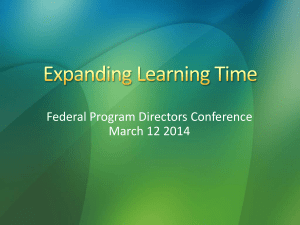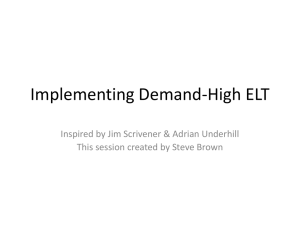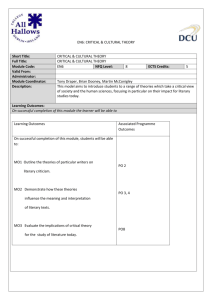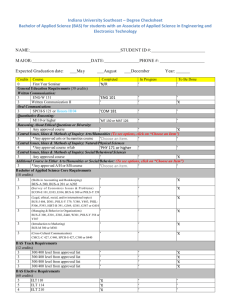Harold E. Palmer, IRLT and ‘Historical sense’ in ELT
advertisement
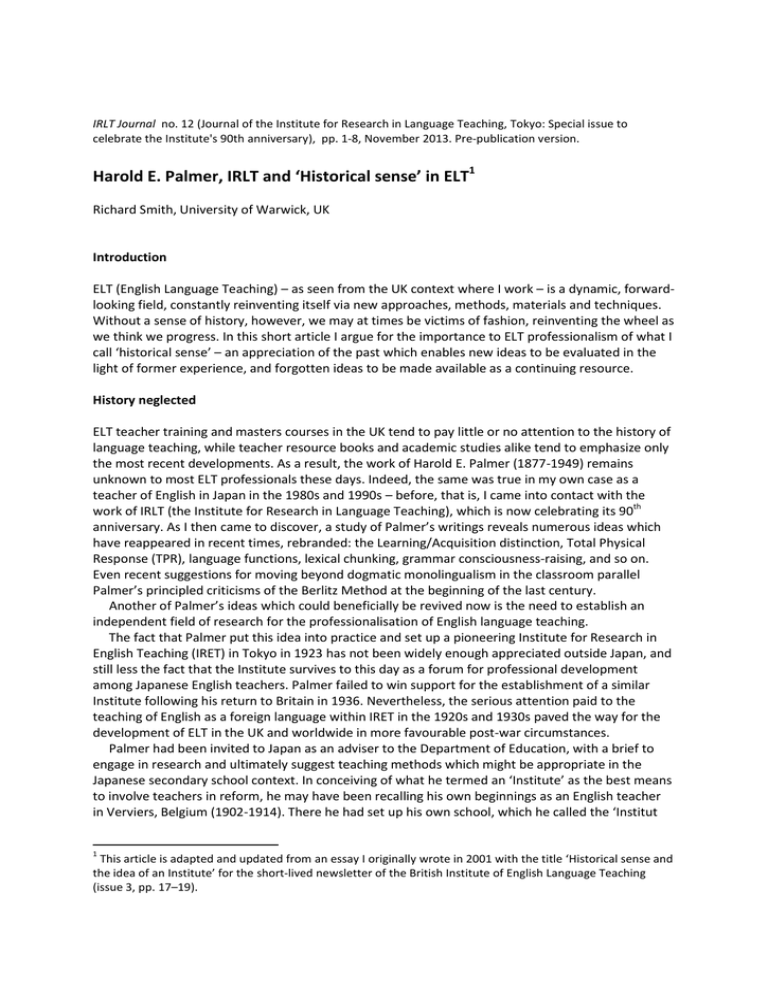
IRLT Journal no. 12 (Journal of the Institute for Research in Language Teaching, Tokyo: Special issue to celebrate the Institute's 90th anniversary), pp. 1-8, November 2013. Pre-publication version. Harold E. Palmer, IRLT and ‘Historical sense’ in ELT1 Richard Smith, University of Warwick, UK Introduction ELT (English Language Teaching) – as seen from the UK context where I work – is a dynamic, forwardlooking field, constantly reinventing itself via new approaches, methods, materials and techniques. Without a sense of history, however, we may at times be victims of fashion, reinventing the wheel as we think we progress. In this short article I argue for the importance to ELT professionalism of what I call ‘historical sense’ – an appreciation of the past which enables new ideas to be evaluated in the light of former experience, and forgotten ideas to be made available as a continuing resource. History neglected ELT teacher training and masters courses in the UK tend to pay little or no attention to the history of language teaching, while teacher resource books and academic studies alike tend to emphasize only the most recent developments. As a result, the work of Harold E. Palmer (1877-1949) remains unknown to most ELT professionals these days. Indeed, the same was true in my own case as a teacher of English in Japan in the 1980s and 1990s – before, that is, I came into contact with the work of IRLT (the Institute for Research in Language Teaching), which is now celebrating its 90th anniversary. As I then came to discover, a study of Palmer’s writings reveals numerous ideas which have reappeared in recent times, rebranded: the Learning/Acquisition distinction, Total Physical Response (TPR), language functions, lexical chunking, grammar consciousness-raising, and so on. Even recent suggestions for moving beyond dogmatic monolingualism in the classroom parallel Palmer’s principled criticisms of the Berlitz Method at the beginning of the last century. Another of Palmer’s ideas which could beneficially be revived now is the need to establish an independent field of research for the professionalisation of English language teaching. The fact that Palmer put this idea into practice and set up a pioneering Institute for Research in English Teaching (IRET) in Tokyo in 1923 has not been widely enough appreciated outside Japan, and still less the fact that the Institute survives to this day as a forum for professional development among Japanese English teachers. Palmer failed to win support for the establishment of a similar Institute following his return to Britain in 1936. Nevertheless, the serious attention paid to the teaching of English as a foreign language within IRET in the 1920s and 1930s paved the way for the development of ELT in the UK and worldwide in more favourable post-war circumstances. Palmer had been invited to Japan as an adviser to the Department of Education, with a brief to engage in research and ultimately suggest teaching methods which might be appropriate in the Japanese secondary school context. In conceiving of what he termed an ‘Institute’ as the best means to involve teachers in reform, he may have been recalling his own beginnings as an English teacher in Verviers, Belgium (1902-1914). There he had set up his own school, which he called the ‘Institut 1 This article is adapted and updated from an essay I originally wrote in 2001 with the title ‘Historical sense and the idea of an Institute’ for the short-lived newsletter of the British Institute of English Language Teaching (issue 3, pp. 17–19). Palmer’, increasingly treating it as a kind of laboratory for what we would nowadays term ‘action research’. He explored the possibilities of various methods, adopting, modifying or rejecting one plan after another, on the basis of experience, as teacher and learner, of several languages. The same action research orientation was to be typical of the activities of IRET: rather than imposing a particular method, Palmer made available a variety of materials, reflecting different lines of approach from which Japanese teachers could choose and with which they could experiment. In this way, a reader-centred oral approach emerged as most popular, and Palmer’s energies were increasingly directed towards the provision of readers amenable to oral work, materials for extensive reading and supplementary teachers’ guides. Again, an experimental approach was favoured, with research being instigated and materials improved in response to problems encountered in writing the materials, as well as reactions gathered through IRET meetings and correspondence. In parallel, Japanese teachers showed more and more willingness to experiment with, adapt and appropriate reformed methods, increasingly contributing articles to the IRET Bulletin (itself also started up in 1923) and engaging in innovative demonstration lessons at the annual Institute Conventions. In some respects, however, the impressive work of IRET did not begin to pay off on a large scale until after the Second World War. A.S. Hornby’s famous Advanced Learner’s Dictionary, for example, was initially conceived and developed as an IRET project, being first published (under a different title) in Tokyo in 1941 and subsequently reprinted by Oxford University Press in 1948. Hornby was the person most responsible for propagating and further developing Palmer’s ideas and the work of IRET in post-war Britain. Indeed, the journal English Language Teaching (now ELTJ) which gave the ELT profession its name was founded by Hornby with the support of the British Council in 1946 on the explicit model of IRET’s Bulletin, which Hornby had himself edited from 1936 to 1941. Before British ELT began to be established in the aftermath of World War II, Palmer and his IRET colleagues had already, in the 1920s and 1930s, provided ‘the essential groundwork on which the profession could build a strong and flexible structure’ (Howatt in Smith 1999: viii). The post-war neglect of Palmer The essentially pragmatic ethos of British ELT in the immediate post-war years – less colonised by linguistic science than was language teaching in the USA – reflected Palmer’s problem-oriented, eclectic but principled philosophy. More specifically, Hornby’s influential Situational Approach, which formed the backbone of post-war British ELT up until the 1970s, was clearly an outcome of his long (almost 20-year) apprenticeship with IRET as an English teacher and researcher in Japan. ELT was institutionalised in Britain as a consequence of new post-war demands which led publishers, the British Council and, later, universities, to take a serious interest. In this new comingtogether of commercial, academic and political interests, ELT was constructed as a modern British invention. The pioneering pre-war work of IRET, a non-commercial, non-academic (though researchbased) endeavour within a nation with which previous ties had been severed, tended, then, to go unacknowledged. In ELT’s infancy its history was denied and has continued to be largely ignored. Meanwhile in Japan, IRLT (the successor to IRET) has continued to operate as an independent teachers’ association, holding annual conventions, publishing this journal, and encouraging teacher research and development in various ways. Significant inspiration is still derived from Palmer’s ideas as adapted to the Japanese context; 1995 saw the republication under IRLT editorship of Palmer’s Selected Writings (IRLT 1995, 10 volumes); in 1999 a one-day conference was arranged to mark the 50th anniversary of his death; and this issue of the IRLT Journal marks the 90th anniversary of the foundation of IRET. Such events contrast markedly with the general lack of interest in history within British ELT (although see the October 2012 issue of ELT Journal (66/4) for some evidence of a recent rise in interest). What might the worldwide ELT profession gain, though, from an enhanced appreciation of the past? At the risk of romanticising IRLT’s achievements, its members do seem to derive an advantageous degree of professional autonomy from consciously working in the Palmerian tradition. Since Palmer’s day, newer methods have come and gone in Japan, as elsewhere. While a broadly ‘communicative’ approach is currently still in vogue, it has perhaps not proved very much more appropriate in secondary schools than the Oral Approach, or audiolingualism, was in the 1960s. In the meantime, IRLT members have access to a more extensive bank of tried and trusted ideas than is available to other reform-minded teachers. Historical sense could surely benefit ELT professionalism more generally. If, rather than being trained in the belief that the latest developments automatically supersede past achievements, teachers were introduced to more impartial versions of ELT history, they might gain a wider perspective, a greater variety of ideas to draw on, and thence a greater ability to assess, and if necessary resist, pressures to follow fashion. The main characteristic of IRLT which has enabled it to preserve and develop the tradition inherited from Palmer seems to have been its relative independence, as an Institute, from academic commercial and political pressures. By contrast, academic, applied linguistic research in the UK (and perhaps elsewhere) which claims relevance to ELT can be seen to be dominated – in terms of quantity at least -- by the demands of large-scale testing agencies. In other ways, too, it often seems divorced from the practical priorities of primary and secondary classroom teachers around the world (Rixon and Smith 2010; Smith 2011a; Smith and Knagg 2012). Some recent developments What can be done to enhance a sense of history in the ELT profession, with a view to reconnecting it with the tradition of problem-oriented, principled research and practice established originally by Palmer – and how can more of a ‘space’ be opened up for practice-focused research which puts teachers’ concerns at centre-stage? The two things, it seems to me, go together – what seems to be needed is a greater focus on recovering the past, and, partly through this process, on re-establishing ELT as a principled field of activity with its own priorities, that is, with an agenda set not by commercial, academic or political agencies but by teachers and teacher educators aware of their own and their students’ contextual needs. I shall end by describing some recent developments I have been involved in which have seemed to me positive in furthering this kind of ideal. Firstly, when I returned to the UK in 2000 after thirteen years’ teaching in Japan, I signed up to the attempt to establish an independent British Institute of English Language Teaching (BIELT), However, this was unfortunately very short-lived - it began accepting members in 1999 but ran into financial difficulties and folded in 2002. My personal hope had been that BIELT would develop an ELT historical collection / archive as a basis for the professionalization which it had been set up to facilitate. When BIELT closed down, I instead put this idea into practice in my own work-place, founding the ELT Archive at the University of Warwick in the same year (www.warwick.ac.uk/go/elt_archive). Since then I have been attempting to promote historical research, with some limited success. My first PhD student in the field of history of ELT – Duncan Hunter – completed his thesis in 2009, uncovering important continuities in the discourse of ELT Journal (see Hunter and Smith 2012). I have myself published some articles which highlight the present-day importance of knowing about Harold Palmer, A.S. Hornby and other pioneers in the overall development of ELT (e.g. Smith 2011b; Bowers and Smith 2012), and most of these are freely downloadable from the ELT Archive website: www.warwick.ac.uk/go/elt_archive/publications. The ‘Hall of Fame’ (www.warwick.ac.uk/go/elt_archive/halloffame) which Duncan helped me to construct and to which we have uploaded photographs, scanned materials and archive recordings is another means we have adopted to attempt to stimulate interest in the history of ELT. In parallel, I have also been involved in – and am equally hopeful about -- recent initiatives to establish ‘ELT research’ as a distinctive area of inquiry in the UK context (see Rixon and Smith 2010). Indeed, establishing that ELT has a research-based history apart from (and older than) applied linguistics goes hand in hand, it seems to me, with a reconfiguration – necessary for other reasons, too – whereby ‘ELT research’ comes to new-found prominence (by this I mean ‘research which is directly relevant to the teaching and learning of English as a second or foreign language’). Of course my conviction that ‘historical sense’ can usefully inform the development of an independent field of this kind originated in my discussions with IRLT colleagues in Japan, and in the histories of IRET and IRLT themselves.2 Conclusion In summary, then, I would emphasise that any profession needs to be at least partly built on an awareness of what has been attempted in the past, even as new knowledge or technology is brought into play. A persistent tendency to deny or demonise the past within British ELT – a tendency which may now slowly be waning -- has gone hand in hand with constant commercially or academically inspired shifts in emphasis which have positioned teachers as victims of fashion. These shifts have counteracted an independent tradition of problem-oriented research and principled practice instigated by Palmer which has been kept alive for all this time – for all of us to learn from -- by the members of IRLT, and which may just now be starting to gain the wider recognition it has always deserved. References Howatt, A.P.R. (1999). Foreword to Smith, Richard C. The Writings of Harold E. Palmer: An Overview. Tokyo: Hon-no-Tomosha, vii-ix. Also online: http://www.warwick.ac.uk/go/elt_archive/publications/smith_1999.pdf Hunter, D. and Smith, R. (2012). 'Unpackaging the past: "CLT" through ELTJ keywords'. ELT Journal 66/4: 430-439. IRLT (eds) (1995). The Selected Writings of Harold E. Palmer (photographically reprinted in 10 volumes). Tokyo: Hon-no-Tomosha. 2 Professor Wakabayahi Shunsuke, in particular, exercised an important influence on me as on so many IRLT members at the time, and I miss our conversations greatly; I also need to acknowledge the great assistance Professor Imura Motomichi gave me in helping me to understand Palmer’s work in Japan. Rixon, S. and Smith, R. (2010). Directory of UK ELT Research, 2005-08. London: The British Council. Also online: http://www.teachingenglish.org.uk/elt-research. Smith, R. (2011a). 'Teaching English in difficult circumstances: A new research agenda'. In Pattison, T. (ed.) IATEFL 2010 Harrogate Conference Selections. Canterbury: IATEFL Smith, R. (2011b). 'Harold E. Palmer’s alternative "applied linguistics"'. Histoire–Epistémologie– Langage 33/1: 53-67. Smith, R. and Bowers, R. (2012). 'A.S. Hornby and 50 years of the Hornby Trust'. ELT Journal 66/1: 19. Smith, R., with Knagg, J. (2012). ‘The state of ELT research in the UK’. ELT Research 27: 5-7. Also online: http://resig.weebly.com/uploads/8/1/4/0/8140071/panel_discussion_report_part_1_-the_state_of_uk_elt_research.pdf
